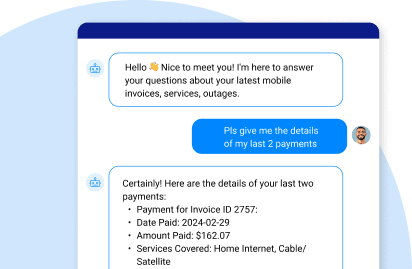Prompt engineering techniques – such as zero-shot, few-shot, chain-of-thought, meta, self-consistency, and role – enhance the accuracy of LLM responses.
LLM prompts are critical to conversational AI
Prompts are the linguistic inputs that guide a Large Language Model (LLM) when it generates a response. They’re basically the instructions, questions, or statements you give your LLM to guide it as it responds to queries. The quality of your prompt is directly related to the quality of the response you receive.
Although the word prompt – defined as language that guides thought and actions – has been around for centuries, it’s only recently been applied to AI. Early language models, developed in the 1990s, relied on simple prompts to generate simple responses. Modern LLMs require more sophisticated prompt techniques, such as the use of LLM agents and functions. Thus, the field of AI prompt engineering was born.
Understanding prompt engineering
Prompt engineering is a relatively new field focused on creating and refining prompts that maximize the effectiveness of LLMs for a wide scope of applications. Researchers employ prompt engineering to enhance LLM responses on tasks that range from answering a simple question to more complex activities like logic or arithmetic reasoning.
Developers use prompt engineering techniques to create robust and efficient prompts that can interact seamlessly with both LLMs and external tools. Prompt engineering is a science that goes far beyond just writing prompts. It involves a broad set of skills essential for working with and developing LLMs. It's key for building, interfacing, and gaining deeper insights into LLM grounding.
The top 6 prompt engineering techniques for 2026
There are numerous prompt engineering techniques in use. The top five of these include:
1. Zero-shot prompting
Zero-shot prompting is a prompt engineering technique that instructs an enterprise LLM to perform a task without providing any examples within the prompt. Instead of steering the model with sample inputs and outputs, a zero-shot prompt relies on the LLM's ability to understand the task based on the instructions alone, leveraging the vast amount of data it has been trained on.
For example, for a given sentiment analysis task, a zero-shot prompt might be,
Classify the following text as neutral, negative, or positive.
Text: I think the vacation was okay. Sentiment:
The model, without any prior examples of sentiment classification in the prompt, can generate the correct output, Neutral.
Real-world applications of zero-shot prompting include tasks like translation, summarization, or content moderation, where pre-defined examples are not always available or even necessary. Massive training and perhaps fine-tuning, combined with an easy-to-understand zero-shot prompt, enable your LLM to perform these tasks accurately.
Best practices for zero-shot prompting include providing clear, concise instructions and avoiding ambiguous or complex tasks where the model might need guidance. If zero-shot prompting proves insufficient, switching to few-shot prompting might help.
2. Few-shot prompting
Few-shot prompting is a technique where examples are included in the prompt, thus facilitating LLM AI learning. This method helps the model learn in context by providing data about the desired task before it’s performed. Few-shot prompting is particularly useful for more complex tasks where zero-shot prompting may not yield satisfactory results.
For example, if the task is to correctly use a new word in a sentence, the prompt might be:
A baku is a large blue flightless bird native to the Hawaiian islands.
An example of a sentence using the word baku is: We saw many bakus on our trip to Maui.
By showing an example, the model can then understand how to generate a correct response using the word in the next task, which might be,
Write a short story about a baku that found itself on a ship bound for California.
Best practices for few-shot prompting include providing clear, representative examples and maintaining consistency in formatting. It’s also important to match the label space and input distribution to the task at hand. Studies show that even when labels are randomized, having examples can significantly improve performance.
Note that for more complex tasks, few-shot prompting may be insufficient, requiring more advanced techniques like chain-of-thought prompting.
3. Chain-of-Thought (CoT) prompting
Chain-of-thought prompting is a technique that enhances the reasoning abilities of large language models by breaking down complex tasks into simpler sub-steps. It instructs LLMs to solve a given problem step-by-step, enabling them to field more intricate questions.
For example, the following chain-of-thought prompt guides the LLM to reason step-by-step:
I started out with 8 marbles. I gave 3 to a friend, and then found 4 more. How many marbles do I have now? Think step by step.
The model would understand this prompt as follows:
You started with 8 marbles.
After giving away 3, you have 5 left.
Then, you found 4 more, so 5 + 4 = 9 marbles.
Best practices for CoT prompting include providing clear logical steps in the prompt as well as a few examples to guide the model. Combining CoT with few-shot prompting can be particularly effective for complex tasks. Additionally, for simple problems, zero-shot CoT can be employed by simply adding a phrase like, Let's think step by step.
4. Meta prompting
Meta prompting is an advanced prompting technique that focuses on structuring and guiding LLM responses in a more organized and efficient manner. Unlike few-shot prompting, which relies on detailed examples to steer the model, meta prompting is a more abstract approach that emphasizes the format and logic of queries.
For example, in a math problem, instead of providing specific equations, a meta prompt outlines the steps or structure needed to come up with the right answer, like:
Step 1: Define the variables.
Step 2: Apply the relevant formula.
Step 3: Simplify and solve.
This approach helps the LLM generalize across different tasks without relying on specific content.
Coding is a frequent real-world application of meta prompting. For example, a developer could create a meta prompt to guide the model to:
Step 1: Identify the coding problem.
Step 2: Write a function.
Step 3: Test it.
This abstract guidance can apply across multiple coding problems without focusing on one specific task.
Best practices for meta prompting include focusing on logical structures, keeping prompts abstract, and ensuring the task’s format is clearly defined. The meta prompt engineering technique is especially useful for token efficiency and for tasks where traditional few-shot examples can lead to biases or inconsistencies.
5. Self-consistency prompting
Self-consistency prompting is an advanced technique that improves the accuracy of chain-of-thought reasoning. Instead of relying on a single, potentially flawed flow of logic, self-consistency generates multiple reasoning paths and then selects the most consistent answer from them. This technique is particularly effective for tasks that involve arithmetic or common sense, where a single reasoning path may not always lead to the correct solution.
For example, consider the problem:
When I was 6, my sister was half my age.
Now I’m 70. How old is my sister?
A LLM might answer 35 (half one’s age). But, with self-consistency prompting, the model generates additional reasoning paths, such as:
When you were 6, your sister was 3.
The difference in your ages is 3 years and that doesn’t vary.
Now that you’re 70, she must be 67.
By comparing the multiple outputs, the most logical answer is selected.
Best practices for self-consistency prompting include sampling multiple outputs and comparing reasoning paths to identify common patterns. Self-consistency prompting is useful for improving model performance on complex reasoning tasks and can be applied to a variety of domains, from arithmetic problems to real-world decision-making.
6. Role prompting
Role prompting (also called persona or role-play prompting) is a technique where you explicitly assign the LLM a role, profession, or perspective to shape how it reasons and responds. Instead of only telling the model what to do, role prompting tells it who to be while doing it. This technique often improves relevance, tone, and domain focus, especially in tasks that benefit from specialized framing.
For example, if the task is to critique a business proposal, a role prompt might be:
You are a skeptical venture capitalist. Review the following pitch and list the top 3 pros and top 3 cons.
< Paste pitch >
By adopting the “skeptical venture capitalist” role, the model is more likely to prioritize financial viability, market risks, and competitive positioning than it normally would.
Real-world applications of role prompting include:
a. Customer support: You are a helpful support agent.
b. Writing and editing: You are a senior copy editor.
c. Teaching and tutoring: You are a patient math tutor.
d. Expert analysis: You are a security auditor assessing the following code.
< Paste code >
These roles guide the model toward the expectations of a target audience or domain.
Best practices for AI prompt engineering include choosing roles that are realistic and task-relevant, briefly stating the role at the start of the prompt, and pairing the role with clear task instructions. Overly elaborate personas can sometimes add noise, so it helps to keep the role definition concise and aligned with the outcome you want.
Prompt engineering embedded in GenAI Data Fusion
K2View leverages chain-of-thought prompting and other prompt engineering techniques in its market-leading Retrieval-Augmented Grounding (RAG) solution, GenAI Data Fusion.
The K2view RAG tools ensure that your LLM prompts – and, consequently, the model’s responses – are grounded in your enterprise data. For example, they assure positive and responsive interactions between your RAG chatbot and your customers.
GenAI Data Fusion:
-
Injects AI-ready data in real time, about a specific entity, for more effective prompts.
-
Masks sensitive data or Personally Identifiable Information (PII) dynamically.
-
Handles data service access requests and suggests cross-/up-sell recommendations.
-
Accesses enterprise systems – via API, CDC, messaging, or streaming – to collect data from multiple source systems in order to create and maintain AI-ready data for your enterprise.
The K2view framework makes your GenAI apps more effective and successful by harnessing the power of RAG prompt engineering.














